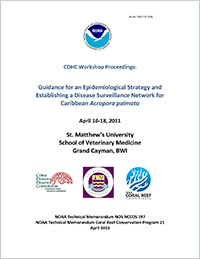-
Home
-
Data & Publications
-
Regional Portals
- About Regional Portals
- Florida
- Navassa Island
- Puerto Rico
- Flower Garden Banks
- U.S. Virgin Islands
- American Samoa
- Commonwealth of the Northern Mariana Islands
- Federated States of Micronesia
- Guam
- Main Hawaiian Islands
- Republic of the Marshall Islands
- Northwestern Hawaiian Islands
- Republic of Palau
- Pacific Remote Island Areas
-
CRCP Activities
- Glossary
Guidance for an Epidemiological Strategy and Establishing a Disease Surveillance Network for Caribbean Acropora palmata

Acropora palmata was listed as threatened under the Endangered Species Act in May 2006 (71 FR
26852). In 2012, the National Marine Fisheries Service proposed the reclassification of A. palmata
(77 FR 73219) as endangered, but determined in 2014, that they would remain listed as threatened
under the ESA (79 FR 53852). This coral is present only in the Caribbean where its existence is
threatened by infectious pathogens, pollution, and human activities. There is a critical need to conserve remaining stocks of corals, but the status of this species is unknown in many regions in the
Caribbean because the capacity to assess their condition and monitor reefs is lacking. This is
particularly challenging in many Caribbean locations (e.g., small island countries). With limited
financial and personnel resources, these managers lack access to a coordinated network of
collaborators. The goal of this workshop was to provide methods that can assist coral reef
managers, particularly those with limited resources, to assess and manage the health of their
respective coral populations with a focus on A. palmata as a sentinel species. Specific aims of this
workshop were as follows:
- Develop survey methods based on the sound principles and theories of epidemiology that can:
- Provide demographic data directly comparable across regions.
- Be simple enough to apply for managers with limited means.
- Have sufficient sensitivity to detect adverse changes on reefs before it is too late to intervene.
- Develop a means to analyze survey data to detect status and trends with the overarching goal to:
- Detect and report declines in populations or recruitment or increase in mortality on a real-time basis.
- Define trigger mechanisms that would merit the recruitment of outside experts to help investigate potential causes of unusual disease outbreaks or increases in mortality.
- Ensure that surveillance design and analyses are sound and appropriate for island
biogeographic settings.
- Design the surveillance methodology and networks targeted to small Marine Protected Areas with limited resources.
- Develop a hierarchical structure, using the U.S. Centers for Disease Control and the World Health Organization as models, to develop an implementation strategy for methods in which surveillance is conducted and data analyzed, to detect anomalies. Resource managers are supplied inexpensive techniques to diagnose the change and then a means of accessing expertise when situations demand more specialized investigations.
- Identify new methods or techniques from the available expertise to incorporate into the overall guidance document.
The format was a working meeting with twelve recognized experts that were tasked with developing a guidance document on disease surveillance and response. Each participant played a vital role in developing the methodology supporting this guidance document; their collective expertise included epidemiology, veterinary medicine, coral physiology, watershed characterization
Citation: Woodley CM, Taylor SM, Downs CA, Austin TJ, Bothwell J, Lawson AB, McCord MR, Ochoa-Vargas G, Risk MJ, Risk J, Thrusfield MV, Work TM (2015) Guidance for an Epidemiological
Strategy and Establishing a Disease Surveillance Network for Caribbean Acropora palmata.
NOAA Technical Memorandum NOS NCCOS 197 and CRCP 21. National Oceanic and
Atmospheric Administration, Charleston, SC. 18pp. doi: 10.7289/V5S75D9J
For more information, contact:


